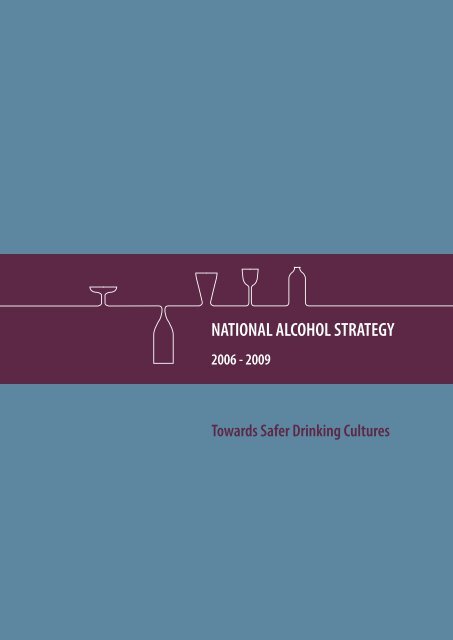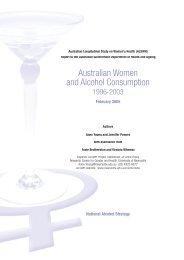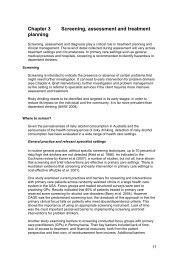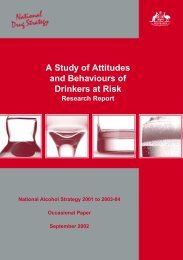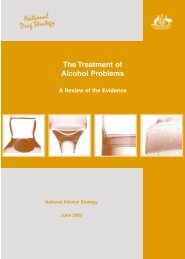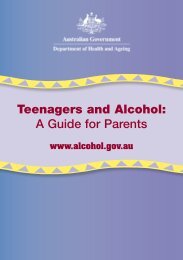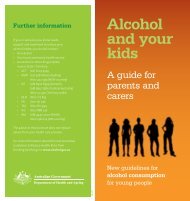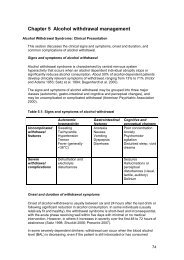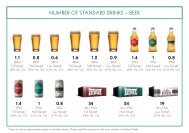National Drug Strategy 2006-2009 - part 1 - posted 18/08/06 - Alcohol
National Drug Strategy 2006-2009 - part 1 - posted 18/08/06 - Alcohol
National Drug Strategy 2006-2009 - part 1 - posted 18/08/06 - Alcohol
Create successful ePaper yourself
Turn your PDF publications into a flip-book with our unique Google optimized e-Paper software.
Towards Safer Drinking Cultures
<strong>National</strong> <strong>Alcohol</strong> <strong>Strategy</strong><strong>20<strong>06</strong></strong> - <strong>2009</strong>Ministerial Council on <strong>Drug</strong> <strong>Strategy</strong>May <strong>20<strong>06</strong></strong>.
This document was endorsed by the Ministerial Council on <strong>Drug</strong> <strong>Strategy</strong> at its meeting inPerth on 15 May <strong>20<strong>06</strong></strong>.The document was prepared for the Ministerial Council by the <strong>Strategy</strong> Development Team,with direction from the Project Management Group and four advisory groups appointed bythe Intergovernmental Committee on <strong>Drug</strong>s (see Appendix 2).For information on the <strong>National</strong> <strong>Drug</strong> <strong>Strategy</strong>http://www.nationaldrugstrategy.gov.auPaper-based publications©Commonwealth of Australia <strong>20<strong>06</strong></strong>This work is copyright. A<strong>part</strong> from any use as permitted under the Copyright Act 1968,no <strong>part</strong> may be reproduced by any process without prior written permission from theCommonwealth. Requests and inquiries concerning reproduction and rights shouldbe addressed to the Commonwealth Copyright Administration, Attorney-General’sDe<strong>part</strong>ment, Robert Garran Offices, <strong>National</strong> Circuit, Barton ACT 2600 or <strong>posted</strong> at http://www.ag.gov.au/ccaInternet sites©Commonwealth of Australia <strong>20<strong>06</strong></strong>This work is copyright. You may download, display, print and reproduce this material inunaltered form only (retaining this notice) for your personal, non-commercial use or usewithin your organisation.A<strong>part</strong> from any use as permitted under the Copyright Act 1968,all other rights are reserved. Requests and inquiries concerning reproduction and rightsshould be addressed to the Commonwealth Copyright Administration, Attorney-General’sDe<strong>part</strong>ment, Robert Garran Offices, <strong>National</strong> Circuit, Barton ACT 2600 or <strong>posted</strong> at http://www.ag.gov.au/ccaISBN: 1 74<strong>18</strong>6 051 2Online ISBN: 1 74<strong>18</strong>6 052 0Publication Approval Number: 3900
CONTENTSExecutive Summary 21. Introduction 42. <strong>Strategy</strong> Framework 63. Context of the <strong>Strategy</strong> 84. Priority Areas4.1 Intoxication 114.2 Public Safety and Amenity 154.3 Health Impacts 204.4 Cultural Place and Availability 255. Where to from here? 30Appendices 32References 36Figures1. Annual costs of alcohol abuse, Australia ($AUD millions).2. <strong>Alcohol</strong>-related harm: determinants, behaviours, and outcomes.3. Total adult per capita alcohol consumption, selected countries (by rank out of<strong>18</strong>5).4. Per capita alcohol consumption in Australia, various sources, 1989 to 2003.5. Prices of alcoholic beverages relative to other consumption (1998/99 = 1.0),Australia, 1973-74 to 2003-04.6. Per capita alcohol consumption by product type, Australian population aged15+ years, 1989 to 2004 (year ending 30 June).7. Per capita alcohol consumption by type of spirits, Australian population aged15+ years, 2003 to 2004 (year ending 30 June).8. Estimated number of deaths from acute conditions due to drinking at levelsrisky or high risk to health, Australia, 1992–2001.9. Main alcohol and drug-related issues reported by local government.10. Proportion of the population who are drinkers and non-drinkers, Australia,2004.11. Estimated number of lives lost and saved for chronic conditions due to drinkingat levels risky or high risk to health, by sex, Australia, 1992-2001.12. Estimated number of hospitalisations caused and prevented for chronicconditions due to drinking at levels risky or high risk to health, by sex, Australia,1993/94 to 2000-01.13. Hospital separation rates related to alcohol use by Aboriginal and Torres StraitIslander status, Australia, 2002-03.14. Growth in the number of liquor licences in Victoria, 1986 to 2004.Tables1. <strong>Alcohol</strong> in the leading 12 selected risk factors as global causes of disease burden.2. Features of Australian drug policy.3. Estimated number of hospitalisations from acute conditions due to drinking atlevels risky or high risk to health, Australia, 1993–94 to 2000–01.4. Principles for effective policing of licensed drinking environments.1
EXECUTIVE SUMMARY<strong>Alcohol</strong> plays an important role in the Australian economy. It generates substantialemployment, retail activity, export income and tax revenue. <strong>Alcohol</strong> also has animportant social role. It is a familiar <strong>part</strong> of traditions and customs in this countryand is often used for relaxation, socialisation and celebration. Eighty three percentof Australians reported drinking alcohol in 2004. It is a drug that can promoterelaxation and feelings of euphoria. It can also lead to intoxication and dependenceand a wide-range of associated harms.The annual cost to the Australian community of alcohol-related social problemswas estimated to be $7.6 billion in 1998-99. Globally, alcohol-related death anddisability accounts for 4.0 percent of the total cost to life and longevity (comparedto 4.1 percent for tobacco), even after factoring in any health protective effects ofalcohol consumption.Although the per capita consumption of alcohol in Australia has declined sincethe 1980’s it remains high by world standards. There are patterns of use that areof <strong>part</strong>icular concern. For example, drinking to intoxication is associated withwide-reaching impacts on the health, safety and wellbeing of individuals andcommunities. Such drinking is not a random occurrence. Many of the dangers ofalcohol for those who drink, and those around them, are misunderstood, toleratedor ignored. The harms associated with unsafe alcohol use, including drinking tointoxication, are now well documented in the research literature. There is alsowidespread concern about the drinking patterns associated with harm amongthose who are responding to those harms in some way on a day-to-day basis.Developing Australia’s drinking cultures to produce healthier and safer outcomesis the key challenge for this <strong>Strategy</strong>.The <strong>National</strong> <strong>Alcohol</strong> <strong>Strategy</strong> <strong>20<strong>06</strong></strong>-<strong>2009</strong>The <strong>National</strong> <strong>Alcohol</strong> <strong>Strategy</strong> <strong>20<strong>06</strong></strong>-<strong>2009</strong> (the <strong>Strategy</strong>) is a plan for actiondeveloped through collaboration between Australian governments, nongovernmentand industry <strong>part</strong>ners and the broader community. It outlines priorityareas for coordinated action to develop drinking cultures that support a reductionin alcohol-related harm in Australia. The <strong>Strategy</strong> seeks to reflect the <strong>National</strong> <strong>Drug</strong><strong>Strategy</strong>: Australia’s integrated framework 2004–<strong>2009</strong> and build on the previousalcohol strategy. It also supports the key result areas of the <strong>National</strong> <strong>Drug</strong> <strong>Strategy</strong>Aboriginal and Torres Strait Islander Peoples Complementary Action Plan 2003–<strong>20<strong>06</strong></strong>, which was endorsed by the MCDS in August 2003.The <strong>Strategy</strong> is based on extensive consultations with over one thousand keystakeholders around Australia and a review of the most recent research literatureand other data relating to trends in alcohol consumption and harm in Australia.The inclusion of liquor licensing authorities, police and local government in theconsultation process represents an effort to integrate with other key groupsincluding the health sector and the alcohol beverage and hospitality industry.<strong>Strategy</strong> Development PrinciplesDevelopment of the <strong>Strategy</strong> has been guided by a set of principles that haveinfluenced the research methods, the frameworks used for analysis, and decisionmakingon policy specific issues. The principles are:• Build on past and present efforts• Consult• Seek evidence• Contemplate future trends and issues• Focus on some key areas• Identify realistic responses.<strong>Strategy</strong> GoalThe goal of the <strong>Strategy</strong> is to prevent and minimise alcohol-related harm toindividuals, families and communities in the context of developing safer andhealthy drinking cultures in Australia.<strong>Strategy</strong> AimsTo achieve this goal, the <strong>Strategy</strong> has four aims:1. Reduce the incidence of intoxication among drinkers.2. Enhance public safety and amenity at times and in places where alcohol isconsumed.3. Improve health outcomes among all individuals and communities affected byalcohol consumption.4. Facilitate safer and healthier drinking cultures by developing communityunderstanding about the special properties of alcohol and through regulationof its availability.In light of the evidence of alcohol-related harm in the general community andwithin specific sub-populations, both universal approaches to reduce overallconsumption and strategies targeted to reduce harm are needed in Australia.Priority Areas for the <strong>Strategy</strong>Reflecting these aims, the following four priority areas have been nominated as thefocus of the <strong>Strategy</strong>:• Priority Area 1: Intoxication1A Increase community awareness and understanding of the extent andimpacts of intoxication.1B Improve enforcement of liquor licensing regulations.1C Ensure the inclusion of Aboriginal and Torres Strait Islander groupsto identify specific responses for Aboriginal and Torres Strait Islandercommunities.1D Implement strategies to reduce the outcomes of intoxication andassociated harm in and around late night (extended hours) licensedpremises and outlets.• Priority Area 2: Public Safety and Amenity2A Prevent and reduce alcohol-related injuries.2B Revise, develop where necessary, and disseminate best practiceguidelines.2C Increase the capacity of local communities, including government, toaddress public health and safety issues associated with alcohol.• Priority Area 3: Health ImpactsThe following responses relate to the health system and therefore do notnecessarily include other responses that can positively affect the health impactsof alcohol, many of which are recommended elsewhere in the <strong>Strategy</strong>.2
3A Initiate a national effort to enhance the capacity and legitimacy of thenursing profession in addressing alcohol-related health problems.3B Promote primary care settings as an accessible and non-stigmatisingopportunity for health promotion, prevention and treatment of alcoholuse problems.3C Improve capacity and encourage a system-wide health response topeople at risk of short-term and longer-term alcohol-related healthproblems.3D Support whole-of-community initiatives to reduce alcohol-relatedhealth problems.• Priority Area 4: Cultural Place and Availability4A Strengthen the regulation of alcohol availability including liquorlicensing controls.4B Investigate price-related levers to reduce consumption of alcohol atharmful levels.4C Monitor and review alcohol promotions.4D Develop and implement social marketing campaigns to reduce alcoholrelatedharms.4E Develop a shared vision for long-term culture change with the aimof reducing alcohol-related harm and developing safer and healthydrinking cultures in Australia.4F Examine the legal aspects of alcohol availability.A fifth area of the <strong>Strategy</strong>, ‘Where To From Here?’ identifies actions required tosupport the implementation of the <strong>Strategy</strong>, including:• Coordinated and integrated approaches• Building the research agenda• Data collection• Monitoring and evaluation• Developing the workforce• Developing <strong>part</strong>nerships and links• Shaping the future - providing strong leadership.The recommended responses are listed under the four priority areas and the fifthsection focussing on implementation of the <strong>Strategy</strong>.3
1. INTRODUCTION1.1 Why does Australia need a <strong>National</strong> <strong>Alcohol</strong> <strong>Strategy</strong>?<strong>Alcohol</strong> enjoys enormous popularity and special significance in Australian society.It is used for relaxation, socialisation and celebration. <strong>Alcohol</strong> also plays a significantrole in the Australian economy, generating substantial employment, retail activity,export income and tax revenue. There is also evidence that alcohol can benefitthe health of some individuals, if consumed at low levels, by contributing to thereduction of cardiovascular disease risk from middle-age onwards. Everyday,thousands of Australians benefit in some way from alcohol.<strong>Alcohol</strong> also has great significance because it is a drug. It is a psychoactive substancethat can promote relaxation and feelings of euphoria. However, it can also impairmotor skills and judgement, produce intoxication and dependence, cause illnessand death and have other harmful effects on our daily social, economic and livingenvironments. Globally, alcohol-related death and disability accounts for 4.0percent of the total cost to life and longevity (compared to 4.1 percent for tobacco).This figure is adjusted to reflect any health protective effects but it does not includeother costs, such as alcohol-related social harms (Babor et al. 2003).In Australia, the annual cost to the community of alcohol-related social problemswas estimated to be $7.6 billion ($5.5 billion tangible) in 1998-99. The greatestcosts are borne by workplaces as a result of reductions in the size and capacity ofthe workforce and worker absenteeism due to alcohol-related issues (see Figure1). These costs are <strong>part</strong>ly offset by the net government revenue from alcoholrelatedtaxes, which is estimated to be $5.5 billion in 2004/05 (DSICA 2005). Thealcohol industry is also a significant contributor to the broader Australian economy,contributing $<strong>18</strong>.3 billion in 2004-05, and directly employing 36,000 people andindirectly contributing to the employment of 205,000 people in pubs, taverns andbars (DSICA 2005).Figure 1. Annual tangible costs of alcohol abuse, Australia ($AUD millions)(Source: Collins and Lapsley 2002).Today there is not a single drinking culture in Australia, but a great diversity,reflecting the varied and changing meanings that alcohol occupies in our lives.Common among these cultures, however, is an unsafe approach to alcohol. To put itplainly, too many Australians now <strong>part</strong>ake in ’drunken’ cultures rather than drinkingcultures. The harms that result from this include deaths, injuries, disease, crime,violence, fires, drowning, verbal abuse, unemployment and family breakdown. Tocontinue in this direction is in nobody’s interests; not individual Australians, theirfamilies and wider communities nor the alcohol beverage and related industries.Developing Australia’s drinking cultures to produce healthier and safer outcomes isthe key challenge for the <strong>National</strong> <strong>Alcohol</strong> <strong>Strategy</strong> <strong>20<strong>06</strong></strong>-<strong>2009</strong>.1.2 What is the <strong>National</strong> <strong>Alcohol</strong> <strong>Strategy</strong>?The <strong>National</strong> <strong>Alcohol</strong> <strong>Strategy</strong> is a plan for action developed through collaborationbetween Australian governments, non-government and industry <strong>part</strong>ners andthe broader community. It outlines priority areas for coordinated action to developdrinking cultures that support a reduction in alcohol-related harm in Australia. The<strong>National</strong> <strong>Alcohol</strong> <strong>Strategy</strong> <strong>20<strong>06</strong></strong>-<strong>2009</strong> has been developed following consultationwith key stakeholders and a review of the most recent research literature and otherdata relating to trends in alcohol consumption and harm in Australia. The <strong>Strategy</strong>seeks to reflect the <strong>National</strong> <strong>Drug</strong> <strong>Strategy</strong>: Australia’s integrated framework 2004–<strong>2009</strong>, which was endorsed by the MCDS in May 2004.Priorities of Australia’s <strong>National</strong> <strong>Drug</strong> <strong>Strategy</strong> 2004–<strong>2009</strong>:1. Prevention2. Reduction of supply3. Reduction of drug use and related harms4. Improved access to quality treatment5. Development of the workforce, organisations and systems6. Strengthened <strong>part</strong>nerships7. Implementation of the <strong>National</strong> <strong>Drug</strong> <strong>Strategy</strong> Aboriginal and TorresStrait Islander Peoples Complementary Action Plan 2003–<strong>20<strong>06</strong></strong>8. Identification and response to emerging trends.(MCDS 2004)The <strong>National</strong> <strong>Alcohol</strong> <strong>Strategy</strong> <strong>20<strong>06</strong></strong>-<strong>2009</strong> is consistent with the <strong>National</strong> <strong>Drug</strong> <strong>Strategy</strong>,although the status of alcohol as a legal drug requires that the priorities be morespecifically developed to address <strong>part</strong>icular aspects of supply and certain patterns ofuse. The <strong>National</strong> <strong>Alcohol</strong> <strong>Strategy</strong> <strong>20<strong>06</strong></strong>-<strong>2009</strong> also supports the six key result areas ofthe <strong>National</strong> <strong>Drug</strong> <strong>Strategy</strong> Aboriginal and Torres Strait Islander Peoples ComplementaryAction Plan 2003–<strong>20<strong>06</strong></strong>, which was endorsed by the MCDS in August 2003.Many of the dangers of alcohol for Australians who drink, and for those aroundthem, are misunderstood, tolerated or ignored. This is <strong>part</strong>icularly apparent withregards to intoxication. The paradoxical affinity that Australians have for a drug thatis harmful to so many, so often, has become the hallmark of many of the nation’sdrinking cultures.4
Key Result Areas of the Aboriginal and Torres Strait IslanderPeoples Complementary Action Plan 2003–<strong>20<strong>06</strong></strong>:1. Enhance community capacity to address current and future issuesand promote their own health and wellbeing.2. Whole-of-government effort in collaboration with non-governmentorganisations to reduce drug-related harm.3. Substantially improved access to health and wellbeing services thataddress drug issues.4. Holistic approaches, from prevention to treatment and continuingcare, that are locally accessible.5. Workforce initiatives to enhance capacity of community-controlledand mainstream service organisations.6. Improved ownership and <strong>part</strong>nerships of research, monitoring,evaluation and dissemination of information.(MCDS 2003)1.3 How has the <strong>Strategy</strong> been developed?A project management group and four advisory groups, comprising representativesfrom a variety of jurisdictions and sectors, have developed the <strong>National</strong> <strong>Alcohol</strong><strong>Strategy</strong> <strong>20<strong>06</strong></strong>-<strong>2009</strong>.The four advisory groups are:• Health and Social Issues Advisory Group• Research Advisory Group• <strong>Alcohol</strong> Beverage and Hospitality Advisory Group• Regulation, Enforcement and Public Amenity Advisory Groupcontext, it is necessary to approach policy decisions with some caution, akin to apublic health concept termed the ‘precautionary principle’ (Babor et al 2003).The main method used in developing the <strong>Strategy</strong> was analysis of information andopinions collected from:• the project management group and advisory groups;• public comments on the consultation paper;• national consultation forums with key stakeholders;• consultations with experts;• a review of the local and international literature;• a review of recent trends in alcohol consumption and harm in Australia; and• a review of recent developments and achievements in alcohol policy at theinternational, national, state/territory and local level.A summary of the findings of the national consultations for the developmentof the <strong>National</strong> <strong>Alcohol</strong> <strong>Strategy</strong> <strong>20<strong>06</strong></strong>-<strong>2009</strong> is provided within thefour priority areas of the <strong>Strategy</strong>.Snapshot of the consultationsConsultations with more than 1,000 stakeholders23 consultations forums around Australia600 feedback forms received42 written submissions received10 Web responses receivedThe inclusion of liquor licensing authorities, police and local government in theconsultation process represents an effort to engage these with other key groupsincluding the health sector and the alcohol beverage and hospitality industry.<strong>Strategy</strong> development has also been guided by a set of principles that haveinfluenced the selection of process and priority setting.Principles• Build on past and present efforts.• Consult.• Seek evidence.• Contemplate future trends and issues.• Focus on some key areas.• Identify realistic responses.The third of these principles cannot always be met. While an evidence base shouldalways be sought in developing alcohol policy, this is sometimes not possiblebecause new issues and questions can emerge ahead of the answers. In this5
2. STRATEGIC FRAMEWORK2.1 What are the priority areas of the <strong>Strategy</strong>?A major challenge in developing the strategic direction for the <strong>National</strong> <strong>Alcohol</strong><strong>Strategy</strong> <strong>20<strong>06</strong></strong>-<strong>2009</strong> is setting the key priorities for action. Given the many anddiverse issues and responses identified in the national consultation, the reviewof recent literature and data, and in the previous <strong>National</strong> <strong>Alcohol</strong> <strong>Strategy</strong>, clearpriorities for action are needed. While there is significant overlap and links betweenthe issues identified, some emerge as higher priorities than others because of theirbroad and continuing impact. Most of these offer opportunities for collaborativeaction.Figure 2. <strong>Alcohol</strong>-related harm: determinants, behaviours, and outcomesSource: Adapted from Kypri, K. A social ecology of alcohol-related harm (inpreparation).The following four priority areas have been nominated as the focus of the <strong>National</strong><strong>Alcohol</strong> <strong>Strategy</strong> <strong>20<strong>06</strong></strong>-<strong>2009</strong>:• Priority Area 1: Intoxication• Priority Area 2: Public Safety and Amenity• Priority Area 3: Health Impacts• Priority Area 4: Cultural Place and AvailabilityFocusing on these four priority areas does not mean that some issues, such asthose outlined as ‘key strategic areas’ in the previous <strong>National</strong> <strong>Alcohol</strong> <strong>Strategy</strong>, willnot receive attention. Instead, many issues will be integrated across the strategicframework in an effort to build linkages and encourage complementary responses.In addition to the responses recommended in each of the priority areas, Section 5 ofthe <strong>Strategy</strong> focuses on ‘Where to from here?’ and includes implementation issuesand priorities in research, evaluation and workforce development.Figure 2 summarises the relationships between the priority areas. It illustrates thatalthough the determinants, behaviours and outcomes of alcohol-related harm aredistinct, many are linked and interact.The underlying premise of the <strong>Strategy</strong> is that the cultural place and availabilityof alcohol represent major determinants, or influences, of behaviours that leadto alcohol-related harm. Throughout the national consultations and the <strong>Strategy</strong>development process there was broad consensus that the most harmful of thesebehaviours is drinking to intoxication. Therefore, Intoxication is targeted as the firstpriority area of the <strong>Strategy</strong>.The impact of intoxicated behaviour on public safety and amenity has beenincreasingly recognised as a major social problem in Australia today. Therefore,Public Safety and Amenity is recommended as the second priority area.As the health outcomes of drinking at harmful levels, both in the short and longterm,continue to be identified as a major preventable disease burden in Australia,Health Impacts is identified as the third priority area of the <strong>Strategy</strong>. The CulturalPlace and Availability of alcohol is addressed specifically in the fourth priority area,underpinning and reinforcing efforts in the other priority areas.There are other social and structural determinants of patterns of alcoholconsumption and of alcohol-related harm including socio-economic status,availability of opportunities for education and employment, disposable income,housing and access to public transport. When examining alcohol consumptionand its impacts globally as well as within communities in Australia, the stage ofdevelopment of the community can significantly influence benefits and burdensassociated with alcohol and highlight <strong>part</strong>icular issues. These factors are beyondthe scope of this <strong>Strategy</strong> but might be significant for some sub-groups.Table 1. <strong>Alcohol</strong> in the leading 12 selected risk factors as global causes of diseaseburdenDEVELOPING COUNTRIESDEVELOPED COUNTRIESHigh MortalityLow MortalityUnderweight <strong>Alcohol</strong> TobaccoUnsafe sex Blood pressure Blood pressureUnsafe water Tobacco <strong>Alcohol</strong>Indoor smoke Underweight CholesterolZinc deficiency Body mass index Body mass indexIron deficiency Cholesterol Low fruit & veg. intakeVit A deficiency Lo fruit/veg intake Physical inactivityBlood pressure Indoor smoke Illicit drugsTobacco Iron deficiency Unsafe sexCholesterol Unsafe water Iron deficiency<strong>Alcohol</strong> Unsafe sex Lead exposureLo fruit /veg intake Lead exposure Childhood sexual abuseSource: Adapted from <strong>Alcohol</strong> in the Global Burden of Disease, 2000 (%total DALYS) (WHO, 2002)6
2.2 What are the goals and aims of the <strong>Strategy</strong>?The following goal and aims have been developed to reflect and support thestrategic intent of the <strong>National</strong> <strong>Alcohol</strong> <strong>Strategy</strong> <strong>20<strong>06</strong></strong>-<strong>2009</strong>.Goal• Prevent and minimise alcohol-related harm to individuals, familiesand communities in the context of developing safer and healthydrinking cultures in Australia.Aims• Reduce the incidence of intoxication among drinkers.• Enhance public safety and amenity at times and in places wherealcohol is consumed.• Improve health outcomes among all individuals and communitiesaffected by alcohol consumption.• Facilitate safer and healthy drinking cultures by developingcommunity understanding about the special properties of alcoholand through regulation of its availability.2.3 What is the scope of the <strong>Strategy</strong>?Through the consultations and research for the <strong>Strategy</strong>, a wide variety of issuesand recommended responses have been identified, including new and innovativeresponses. All of the potential responses identified have been scrutinised in relationto what are known to be the critical factors for successful drug policy in Australia, asrecognised by the <strong>National</strong> <strong>Drug</strong> <strong>Strategy</strong> 2004-<strong>2009</strong> (see Table 1).Table 2. Features of Australian drug policyHarm minimisation – recognises the need to use a wide range of approachesin dealing with drug-related harm, including supply reduction, demandreduction (including abstinence oriented interventions) and harm reductionstrategies.In light of the evidence of alcohol-related harm in the general community andwithin specific sub-populations, both universal approaches to reduce consumptionand strategies targeted to reduce harm are needed in Australia.What is proposed represents a public health approach and it should be recognisedthat ‘public health often competes with other social values such as free trade,open markets and individual freedom’ (Babor et al 2003). Australia has providedleadership and received international acclaim for public health and social policiesdesigned to reduce morbidity and mortality associated with drink driving,speeding and not wearing seatbelts, to nominate just a few. Striking the balanceis a significant challenge for the development of an effective <strong>National</strong> <strong>Alcohol</strong><strong>Strategy</strong>.2.4 What type of response is recommended?A set of characteristics emerges as essential in developing responses to thefour priority areas of the <strong>National</strong> <strong>Alcohol</strong> <strong>Strategy</strong> <strong>20<strong>06</strong></strong>-<strong>2009</strong>. It is intendedthat all responses recommended for implementation possess the followingcharacteristics:1. Evidence-based with capacity for process, impact, and outcomeevaluations.2. Achievable within <strong>Strategy</strong> timeframe.3. Balance of whole-of-population and targeted strategies.4. Link to or build upon existing responses.5. Clearly relate to a longer-term vision to reduce harm.Where there is limited or no evidence base, the precautionary principlecould apply and expert opinion may be sought.There are many different groups that need to be involved in taking action to achievethe goal and aims of this <strong>Strategy</strong>. Some responses will require <strong>part</strong>nerships whilegovernment or interest group action might achieve others. It will be importantto engage the broader community in contemplation of, and conversations about,alcohol issues in developing some responses.Comprehensive approaches – encompasses the harmful use of licit drugs(tobacco, alcohol and pharmaceutical drugs), illicit drugs and other substances(inhalants, kava).Inter-sectoral <strong>part</strong>nerships – between health, law enforcement and educationagencies, affected communities, business and industry.A balanced approach – across all levels of government, between supplyreduction, demand reduction and harm reduction strategies, betweenpreventing use* and harms and facilitating access to treatment.MCDS (2004)* In relation to alcohol, ‘preventing use’ includes preventing risky and high riskdrinking and preventing underage drinking.7
3. CONTEXT OF THE STRATEGY3.1 What has occurred since the previous <strong>Strategy</strong>?InternationalOne of the most significant developments at the international level has been therelease of the World Health Organisation’s (WHO) sponsored report <strong>Alcohol</strong>: NoOrdinary Commodity: Research and Public Policy (Babor et al 2003). This body ofwork represents a significant advance in our understanding of the application ofevidence in the development of effective alcohol policies.Growing international concern about alcohol has prompted several countries with asimilar socio-political and cultural profile to Australia to develop national strategiesto reduce alcohol-related harm. This includes New Zealand, England, Ireland,Scotland, Canada, Sweden, and the USA’s strategy to reduce underage drinking.International trade agreements have served to weaken national level alcoholcontrols, which has raised public health concern and led to calls for an internationalframework convention or treaty on alcohol. Concern has also arisen from thepossible inclusion of alcohol in the Pacific Island Countries Trade Agreement(PICTA). As a significant exporter of alcohol, Australia has a responsibility and is ina position to provide leadership to regional neighbours to minimise the social andpublic health risks associated with increased availability of alcohol.<strong>National</strong>In May 2004, the <strong>National</strong> <strong>Drug</strong> <strong>Strategy</strong>: Australia’s Integrated Framework 2004–<strong>2009</strong> was endorsed by the MCDS. It provides the framework for the <strong>National</strong> <strong>Alcohol</strong><strong>Strategy</strong> <strong>20<strong>06</strong></strong>-<strong>2009</strong> and other national strategies, including:• <strong>National</strong> <strong>Drug</strong> <strong>Strategy</strong> Aboriginal and Torres Strait Islander People’sComplementary Action Plan 2003–<strong>20<strong>06</strong></strong>• <strong>National</strong> Tobacco <strong>Strategy</strong> 2004–<strong>2009</strong>• <strong>National</strong> Cannabis <strong>Strategy</strong> (under development)These strategies relate to other recent national strategies for mental health, suicideprevention, road safety, injury prevention, nutrition and others.New nationally relevant research and resources on alcohol issues have also beenpublished, such as:• Counting the costs: Estimates of the social costs of drug abuse in Australia in1998–9 (Collins & Lapsley 2002)• 2004 <strong>National</strong> <strong>Drug</strong> <strong>Strategy</strong> Household Survey (AIHW 2005)• Australian <strong>Alcohol</strong> Indicators 1990–2001 (Chikritzhs et al 2003) and the<strong>National</strong> <strong>Alcohol</strong> Indicators Project (NAIP) Bulletins 1 to 7• The Prevention of Substance Use, Risk and Harm in Australia: A Review of theEvidence (Loxley et al 2004)• Revised edition of The Grog Book – Strengthening Indigenous CommunityAction on <strong>Alcohol</strong> (Brady 2005)Other recent national achievements include the work of the <strong>Alcohol</strong> Educationand Rehabilitation Foundation (AERF) and a range of initiatives of the Australian<strong>National</strong> Council on <strong>Drug</strong>s (ANCD) and the Intergovernmental Committee on<strong>Drug</strong>s (IGCD) (including working groups and projects). Other peak bodies alsocontribute, such as the <strong>Alcohol</strong> and Other <strong>Drug</strong> Council of Australia (ADCA),the <strong>National</strong> <strong>Alcohol</strong> BeverageIndustries Council (NABIC) and,most recently, the Australian <strong>Drug</strong>Foundation (ADF) through itsThinking Drinking 2020: AchievingCultural Change conference inFebruary 2005. New and emergingbodies have also been observed,such as the Community <strong>Alcohol</strong>Action Network (CAAN) andthe alcohol industry sponsoredfoundation Drinkwise Australia.States and territoriesMost states and territories are involved in alcohol policy-related activities, includingthe development or implementation of strategies for dealing with alcohol-relatedharms in their jurisdictions and liquor licensing reviews. Examples include:• Outcomes of New South Wales Summit on <strong>Alcohol</strong> Abuse 2003: Changing the Cultureof <strong>Alcohol</strong> Abuse in New South Wales, including the forthcoming NSW Youth <strong>Alcohol</strong>Action Plan <strong>20<strong>06</strong></strong>-<strong>2009</strong>, and NSW <strong>Alcohol</strong> Disease Prevention Plan <strong>20<strong>06</strong></strong>-<strong>2009</strong>• Western Australia <strong>Alcohol</strong> Plan <strong>20<strong>06</strong></strong>-<strong>2009</strong>• Queensland <strong>Alcohol</strong> Management Plans (2002 ) and the 17-point BrisbaneCity Safety Action Plan (2005)• Parliament of Victoria, <strong>Drug</strong>s and Crime Prevention Committee Inquiry intoStrategies to Reduce Harmful <strong>Alcohol</strong> Consumption (2004/05)• The Northern Territory’s <strong>Alcohol</strong> Framework Interim Report and Final Report(2004) and the earlier Living with <strong>Alcohol</strong> Program (1992-2002).LocalLocal governments around Australia are involved in developing and delivering anarray of alcohol harm minimisation programs. They support existing and emergingnational and state/territory strategies and work at a local level with businessand industry, community groups and residents. The role of local government inresponding to alcohol issues includes direct service provision, such as public health,information, family and children, aged care and welfare services, land use planningand public space management, road safety, and co-enforcement with otherregulatory agencies to provide a consistent and multifaceted approach.Given this activity across the country, now is a timely opportunity to engage thenation in coordination and action using the goal, aims and principles of the <strong>National</strong><strong>Alcohol</strong> <strong>Strategy</strong> <strong>20<strong>06</strong></strong>-<strong>2009</strong> as the blueprint.3.2 What are the current consumption patterns and emergingtrends?Data relating to both aggregate level (per capita) alcohol consumption and tospecific sections of the Australian community provides important informationin the <strong>Strategy</strong> formulation process. Per capita consumption is ‘to a considerableextent, related to the prevalence of heavy use, which in turn is associated withnegative effects’ (Babor et al 2003, p31). Per capita alcohol consumption inAustralia is relatively high, ranked 34th out of <strong>18</strong>5 countries compared by the WHO.Figure 3 shows the WHO’s most recent estimate of per capita alcohol consumptionin Australia compared to other selected developed countries.8
Figure 3. Total adult per capita alcohol consumption, selected countries (by rankout of <strong>18</strong>5) (Countries selected with similar cultural, social and economic profile)(Source: WHO 2005)While estimates of per capita consumption of alcohol in Australia over the past20 years vary depending on the source and basis of analysis used, they do showa similar trend.The available consumption estimates for Australia show:• Per capita alcohol consumption in Australia steadily declined from the late1980s until early 1990s when the consumption began to fluctuate.• Over the past decade there has been a steady increase in the proportion of theAustralian population who drink, reaching 83 percent in 2004 (AIHW 2005).• 1.46 million Australians consume alcohol on a daily basis, 600,000 (41percent) of whom are aged sixty years or older (AIHW 2005).• The real price of alcohol in Australia has remained relatively low, and droppedin some cases. For example, a glass of wine costing $1.00 in 1998-99 hasdropped in real terms, to $0.96 in 2003-04.The availability of reliable data on alcohol consumption in Australia remains acontentious issue. While there are estimates of per capita alcohol consumption inAustralia, there are no longer any accurate records of actual consumption since thecollection of wholesale alcohol sales data ceased in some jurisdictions in 1997.Consequently, there are now at least four different estimates published from fourdifferent sources using four different methodologies (see Figure 4). The mainreasons for differences between estimates relate to the source of the primary dataand assumptions about the drinking population. For instance, while both the WorldAdvertising Research Centre’s (WARC) and Australian Bureau of Statistics (ABS)estimates are derived using the same source data of total litres of pure alcoholconsumed each year, the WARC estimates are derived using the total population ofAustralia, while the ABS estimates are derived using the population aged 15 yearsand over. The result is that the WARC estimates are likely to be a significant underestimateof per capita alcohol consumption in Australia. However, it must stillbe emphasised that the estimates from the ABS, the <strong>National</strong> <strong>Alcohol</strong> IndicatorsProject (NAIP), and the WHO are also likely to contain some inaccuracies.Figure 4. Per capita alcohol consumption in Australia, various sources, 1989 to 2003(Sources: WHO 2005; ABS 2005b; NAIP=Chikritzhs et al 2003; WARC 2005).Figure 5. Prices of alcoholic beverages relative to other consumption (1998/99 =1.0), Australia, 1973-74 to 2003-04 (Source: ADCA 2005)• The price of spirits in Australia, in real terms, has remained almost unchangedover the past decade.• One in five (20.6 percent) Australians drink at levels that are risky or a high riskof harm in the short-term at least once a month. This is <strong>part</strong>icularly evidentamong young adults (AIHW 2005) 1 .• Australians aged 20–29 are the most likely of all age groups to drink at levelsthat are risky or a high risk of harm in the short-term (AIHW 2005).• Between 2001 and 2004, the proportion of Australian women who drank atleast weekly increased from 33 percent to 35 percent (AIHW 2005).• Around one third of males (30.5 percent) and one quarter of females (25percent) aged in their 20s drink at risky or high risk levels for short-term harmat least once per month (AIHW 2005).• In 2001, 85 percent of the total alcohol consumed by 14 -17 year old femaleswas drunk at risky/high risk levels for short-term harm. For males this figurewas 80 percent (Chikritzhs et al 2003).91See Appendix 3 for explanation of low risk, risky, and high risk drinking.
• Between 1990 and 2003, the trend in total alcohol-caused deaths showeda general decline, similar to that for per capita consumption (Chikritzhs et al2003).• Following a period of national decline in youth alcohol-attributable deathsduring the 1990s, in more recent years, several states and territories havebegun to record increases (Chikritzhs & Pascal 2004).• Aboriginal and Torres Strait Islander peoples are less likely to be currentdrinkers compared to the general population, although those who do drink aremore likely to do so at risky levels. Aboriginal and Torres Strait Islander youth,compared to their non-Aboriginal and Torres Strait Islander counter<strong>part</strong>s, are2.3 times more likely to die from alcohol-related causes (Chikritzhs & Pascal2004).• There have been significant shifts in the alcoholic product preferences inAustralia, characterised by declines in the consumption of beer and increasesin the consumption of wine and spirits (see Figure 6).Figure 6. Per capita alcohol consumption by product type, Australian populationaged 15+ years, 1989 to 2004 (year ending 30 June) (Source: ABS 2005b)• The increases in consumption of spirits have been driven by increasedconsumption of ‘Ready to Drink’ (RTDs) pre-mixed spirits products (see Figure7).Figure 7. Per capita alcohol consumption by type of spirits, Australian populationaged 15+ years, 2003 to 2004 (year ending 30 June) (Source: ABS 2005b)• Recent research into the alcohol beverage preferences of 15-17 year olds (abouttheir drinking within previous three months) has found that amongst males,there has been a decrease in the proportion who reported consuming fullstrengthbeer, from 46 percent in 2000 to 36 percent in 2004, but an increase inthe proportion who reported consuming pre-mixed spirits, from 14 percent to 36percent over the same period (King et al 2005).• This trend was even more pronounced among females, where there has beena decrease in the proportion who reported consuming full-strength beer,from 15 percent to 8 percent, but an increase in the proportion who reportedconsuming pre-mixed spirits, from 14 percent to 62 percent (King et al2005).In summary, these data show that Australia’s per capita alcohol consumption, as best it can beestimated, remains relatively high in comparison to many other developed countries and hasfluctuated since the mid to late 1990s. A reduction in negative consequences associated withalcohol consumption can be expected if a downward trend in risky and high risk consumptionpatterns occurs. Reductions in harm would also be expected from per capita decline along withtargeted interventions to address some specific sub-populations (youth, including underagedrinkers, Aboriginal and Torres Strait Islander peoples and those drinking to intoxication).3.3 What are the public perceptions about alcohol consumptionand how to respond?There has been a recent increase in public concern about alcohol. Respondents tothe 2004 <strong>National</strong> <strong>Drug</strong> <strong>Strategy</strong> Household Survey (AIHW 2005) were asked: Whenpeople talk about ‘drug problem’, which are the first two drugs you think of? Ten percentof respondents nominated alcohol, compared to 7.8 percent in 2001 (AIHW 2005).When the general population was asked to nominate possible measures to reducealcohol-related harm the following responses were given by more than half ofthose surveyed:• increasing the number of alcohol-free events (63.3 percent);• increasing the number of alcohol-free dry zones (63.3 percent);• Serving only low-alcohol beverages at sporting events (60.6 percent);• limiting TV advertising until after 9.30 pm (71.4 percent);• more severe penalties for drink driving (85.9 percent);• stricter laws against serving drunk customers (83.8 percent);• restricting late-night trading of alcohol (51.9 percent);• strict monitoring of late-night licensed premises (72.1 percent);• increasing the size of standard drink labels on alcohol containers (66.4 percent); and• adding national drinking guidelines to alcohol containers (69.9 percent).One third or more supported reducing pub and club trading hours, banning alcoholsponsorship at sporting events and increasing the tax on alcohol to pay for health,education and treatment of alcohol problems (AIHW 2005).Research that relates to the four priority areas is presented in the nextsections. Key findings from the national consultations are also reportedin these sections. While not from a general population sample, these datado capture frequently expressed views and opinions. A brief outline of theconsultation methodology can be found in Appendix 4.10


